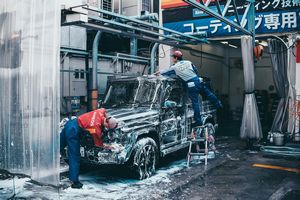|
By accessing/using The Crittenden Automotive Library/CarsAndRacingStuff.com, you signify your agreement with the Terms of Use on our Legal Information page. Our Privacy Policy is also available there. |

A Brief History Of Car Washing
|
|---|
|
|
A Brief History Of Car Washing
Lucy Wyndham
27 August 2019
We love our cars and that’s evident given the
$5.8 billion American’s spend each year at car wash facilities to have their car cleaned and detailed. The US car cleaning industry is big business. It’s
16,000 car washes in America alone add up to yearly revenues of around $9 billion. These businesses clean, wash and wax all kinds of vehicles and are owned and operated by small to medium-sized independent companies alongside medium to larger petroleum companies. The carwashing industry has evolved over the years in response to changing technology, car design, and environmental concerns. But regardless of our
car's make and model, this hasn’t stopped our desire to keep our pride and joy looking at it's best.
Environmental Influence On Carwash Industry
It’s estimated that 38 gallons of water are used each time one car is washed at a car wash. But while this may seem like a lot, commercial car washes minimize how much water is used with computer-controlled systems and high-pressure jets. Modern high pressured steam technology is increasingly seeing car washes use less water while resulting in almost no water runoff which would otherwise end up running into drains.
Improved eco-friendly cleaning solutions also avoid the need to use traditional detergents which offered contained chemicals harmful to the environment. Many car washes re-use the rinse water and ensure the dirty water ends up in the sewage system where it can be treated, rather than rivers and streams. This has led to some countries such as Germany
banning motorists from washing cars at home, viewing carwashes as the more eco-friendly alternative.
The First Car Wash
The first gasoline-powered vehicle might be credited to Karl Benz in Germany back in 1885, but automobiles become more widely available and affordable in 1908 with the launch of the Ford Motor Company’s Model T. It wasn’t long after that the first professional carwashing businesses arrived on the scene. It’s generally thought that the first production line carwash was opened by
Automobile Laundry in Detroit, Michigan in 1914. Initially, workers would push the cars through an assembly line tunnel, while each worker would have a specific job to do such as putting on the soap, rinsing or drying the car. Early advances in car washing in the 1920s saw Chicago’s Auto Wash Bowl introduce a special cleaning area where motorists would drive their cars in circles to get the mud off their tires and undercarriage, then park their car for detailed cleaning.
Introduction Of Automation
Carwashing gradually became semi-automated in the 1940s with the first automatic conveyor car wash in Hollywood, California. The carwash used a winch system to pull vehicles along, while attendants scrubbed and dried the vehicles. Automated washing continued to progress and in 1946 a new car wash was opened that had an overhead sprinkler system that would wet down vehicles before workers scrubbed the cars. The first automatic carwash is thought to have been Paul’s Auto Wash in Detroit using automated car washing equipment created by Leo Rouseau the founder of Minit-Man Inc. Carwashing became entirely automated in 1951, when Eldon, Dean and Archie Anderson added nozzles that could apply soap and water, along with automated brushes and a 50 horsepower dryer to their Washington carwash.
Evolution Of The Carwash
In the 1950s, Dan Hanna Sr opened his carwash Rub-a-Dub in Oregon. As his company grew he saw a need for faster and more efficient equipment. By the mid-1060s, Hanna Enterprises became the largest carwashing equipment company in the world. Carlo Pecora saw a need to speed up the process and in the 1960s opened an exterior-only carwash which later evolved into the flex-serve carwash in the 1980s which offered a full-service option or an express detail service. It wasn’t until 2011 that Ben Alford opened the first automated express carwash at Benny’s Car Wash in Louisiana that offered automated pay terminals and gates. The site provided pay stations and free vacuums designed to be more convenient and faster for customers. This modern and express carwash model quickly become available to operators all across the country, saving time and labor while improving wash volumes and quality of the clean. Technology continues to focus on making the carwash process more streamlined, environmentally-focused and easier for customers.
The carwash industry has seen a huge transformation over the last century and is now a fast, efficient and cost-effective process to ensure our beloved motor vehicles are always looking their best.


















